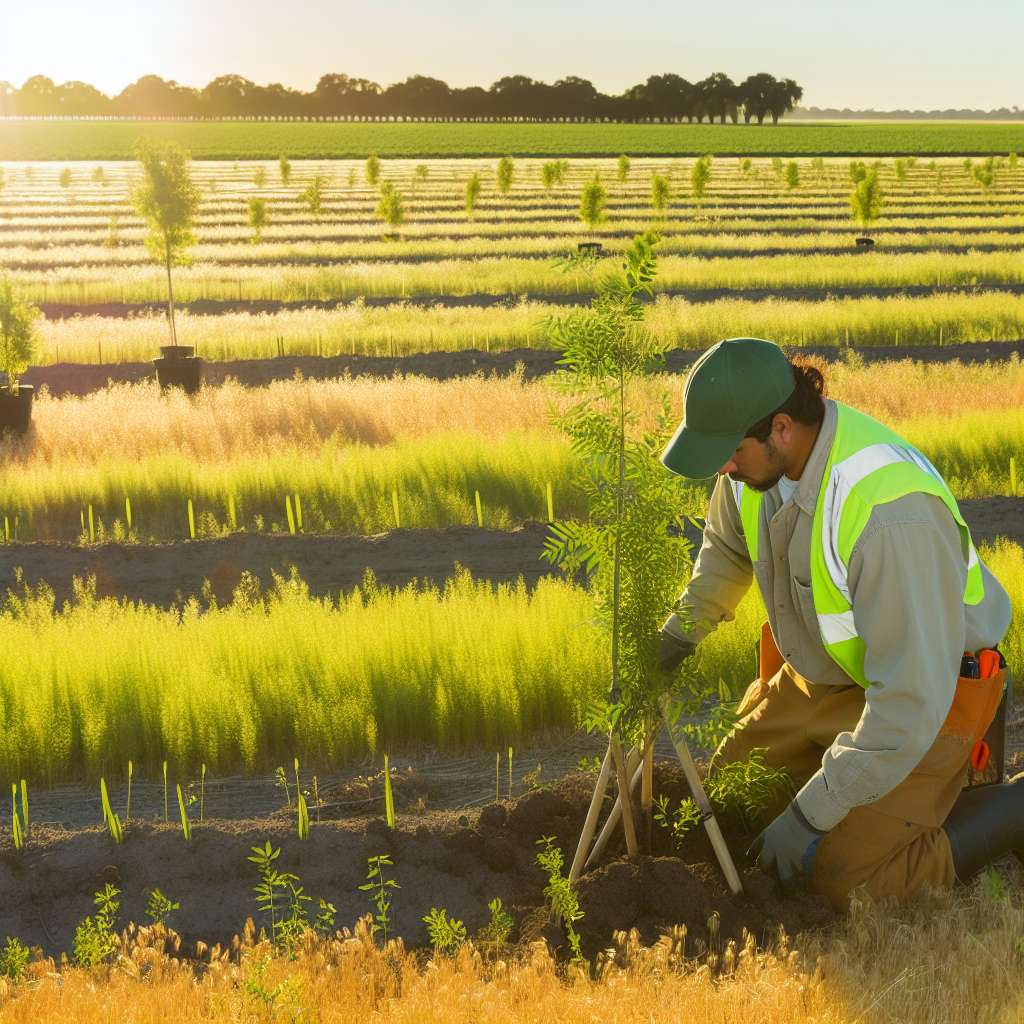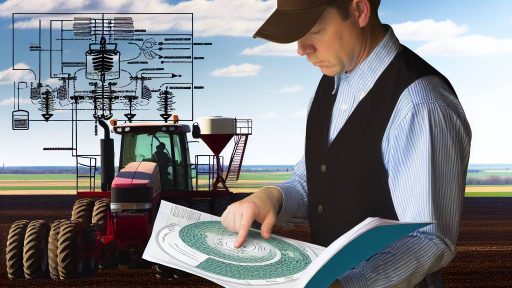Introduction to Agroforestry and its Basics
Agroforestry is a sustainable land-use practice.
It combines agriculture and forestry.
This method integrates trees and shrubs into farmland.
As a result, it enhances both productivity and biodiversity.
Farmers utilize various agroforestry systems.
These systems include alley cropping, silvopasture, and forest farming.
Each system offers unique benefits to ecosystems and farming practices.
Alley cropping involves planting crops between rows of trees.
This approach maximizes land use and improves soil health.
Additionally, it provides shade for crops, reducing water loss.
Silvopasture integrates livestock, trees, and forage.
This combination creates a diverse habitat for wildlife.
Furthermore, it enhances soil structure and nutrient cycling.
Forest farming is another agroforestry practice.
It allows farmers to cultivate high-value crops under a forest canopy.
Transform Your Agribusiness
Unlock your farm's potential with expert advice tailored to your needs. Get actionable steps that drive real results.
Get StartedThis practice promotes biodiversity by providing habitats for various species.
Agroforestry contributes to enhanced biodiversity on farmland estates.
It supports the coexistence of different plant and animal species.
Consequently, it promotes healthier ecosystems.
Additionally, agroforestry improves resilience against climate change.
By increasing vegetation cover, it helps regulate temperature and moisture levels.
Farmers benefit economically from agroforestry.
They can diversify their income sources by growing trees alongside traditional crops.
This practice reduces risks associated with market fluctuations.
Moreover, agroforestry practices promote soil conservation.
The roots of trees stabilize the soil and prevent erosion.
This leads to improved soil fertility over time.
Agroforestry plays a pivotal role in sustainable farming.
It promotes biodiversity while offering economic benefits.
Ultimately, this approach ensures the long-term viability of farmland ecosystems.
Overview of Biodiversity and its Importance on Farmland
Defining Biodiversity
Biodiversity refers to the variety of life forms on Earth.
It encompasses different species, ecosystems, and genetic variations.
This richness supports ecosystem functions and resilience.
Why Biodiversity Matters
Biodiversity is essential for maintaining ecological stability.
It promotes healthy ecosystems that can withstand challenges.
With diverse species, farms can better resist pests and diseases.
Biodiversity’s Role in Agriculture
Agricultural biodiversity enhances food security.
Diverse crops provide a broader range of nutrients.
It also helps adapt to changing climate conditions.
Showcase Your Farming Business
Publish your professional farming services profile on our blog for a one-time fee of $200 and reach a dedicated audience of farmers and agribusiness owners.
Publish Your ProfileCurrent Challenges to Biodiversity
Modern farming practices often harm biodiversity.
The use of chemical inputs reduces species variety.
Additionally, habitat destruction impacts wildlife populations.
Benefits of Increased Biodiversity on Farmland
Higher biodiversity can improve soil health and fertility.
It encourages natural pest control through predator-prey relationships.
Furthermore, it fosters a resilient agricultural system.
Agroforestry and Biodiversity
Agroforestry integrates trees and shrubs into farming systems.
This practice enhances habitat diversity and species richness.
Moreover, it improves overall land productivity and sustainability.
How Agroforestry Enhances Soil Health and Structure
Improving Soil Structure
Agroforestry practices significantly enhance soil structure.
Roots of trees and shrubs bind the soil effectively.
This binding reduces soil erosion during heavy rains.
Consequently, agroforestry fosters improved water infiltration rates.
Moreover, it helps maintain soil moisture levels.
Enhancing Soil Fertility
Agroforestry systems boost soil fertility through organic matter additions.
Decomposing leaves and branches enrich the soil nutrition.
This process encourages a diverse array of soil organisms.
In turn, these organisms contribute to nutrient cycling.
Thus, the overall health of the ecosystem improves.
Minimizing Soil Compaction
Soi compaction inhibits root growth and water absorption.
Agroforestry practices mitigate this issue effectively.
The diverse root systems of trees create channels in the soil.
These channels allow for better air circulation and drainage.
Ultimately, crops benefit from more accessible nutrients.
Promoting Soil Biodiversity
Agroforestry enhances the diversity of soil organisms.
This diversity increases resilience against pests and diseases.
Diverse microbial communities contribute to healthier soils.
Additionally, they play vital roles in soil fertility.
Farmers gain increased yields without relying heavily on chemicals.
Delve into the Subject: How Real Estate Investors Benefit From Sustainable Farmland Irrigation
Role of Agroforestry in Habitat Creation for Wildlife
Enhancing Biodiversity Through Habitat Variety
Agroforestry systems significantly increase habitat variety on farmland estates.
They blend agricultural crops with trees and shrubs, providing diverse environments.
This diversity supports various species that thrive in distinct settings.
Providing Shelter and Food Sources
Trees and shrubs in agroforestry create essential shelter for small mammals and birds.
These plants also serve as food sources for numerous species over different seasons.
Insects and other invertebrates find habitats in the leaf litter and bark.
Encouraging Pollinators
A diverse agroforestry landscape attracts beneficial pollinators like bees and butterflies.
These pollinators play a critical role in the productivity of crops.
Farmers can enhance fruit and vegetable yields by increasing their populations.
Building Connectivity Between Habitats
Agroforestry creates corridors between isolated habitats in farmland areas.
Showcase Your Farming Business
Publish your professional farming services profile on our blog for a one-time fee of $200 and reach a dedicated audience of farmers and agribusiness owners.
Publish Your ProfileThese corridors enable wildlife to move freely and access resources.
Such connectivity helps maintain genetic diversity among species.
Mitigating Climate Change Effects
Agroforestry practices help combat climate change by sequestering carbon.
This, in turn, creates a more stable environment for wildlife.
Furthermore, increased shading can lower soil temperatures, benefiting many species.
Promoting Soil Health
Healthy soil supports plants and the wider ecosystem, enhancing biodiversity.
Trees enhance soil structure and fertility through organic matter contributions.
In addition, deep-root systems prevent erosion and improve water retention.
Encouraging Sustainable Practices
Integrating agroforestry encourages sustainable farming practices across estates.
Farmers adopting these methods often witness a resurgence in local wildlife populations.
Agroforestry systems represent a holistic approach to farming.
See Related Content: Agroforestry Techniques for Enhancing Soil Health on Agricultural Land
Impacts of Agroforestry on Pest Management and Crop Resilience
Enhanced Biological Pest Control
Agroforestry systems promote diverse habitats for beneficial insects.
This diversity helps in natural pest control effectively.
Moreover, canopy layers offer nesting places for predatory birds.
Consequently, the overall pest population diminishes significantly.
Crop Resilience Through Diversity
Planting different crops alongside trees builds resilience against diseases.
Mixing species also helps mitigate the risk of crop failure.
Diverse root structures enhance soil health and stability.
Therefore, agroforestry contributes to sustainable agriculture practices.
Microclimate Benefits
Trees influence the microclimate in farmland areas positively.
They provide shade, reducing temperature extremes for crops.
Consequently, this leads to improved plant growth and yield.
Additionally, the trees’ presence can enhance moisture retention in the soil.
Soil Health Improvement
Agroforestry practices increase organic matter in the soil.
Root systems from diverse plants prevent soil erosion effectively.
Moreover, this approach helps in nitrogen fixation from leguminous trees.
Consequently, nutrients become more accessible for crops.
Economic Advantages
Agroforestry can lead to increased income for farmers.
Diverse products such as fruits, nuts, and timber can be sold.
Moreover, ecosystem services can reduce input costs for pest management.
Thus, farmers can achieve better economic stability through this method.
Explore Further: Mitigating Climate Risks: Economic Approaches for Farmers

Integrating Trees and Crops: Best Practices for Biodiversity
Understanding Agroforestry
Agroforestry combines agriculture and forestry practices.
This method increases biodiversity on farmland estates.
Farmers can integrate trees with crops effectively.
Overall, it promotes healthy ecosystems and resilience.
Choosing Compatible Species
Selecting the right tree species is critical.
Farmers should consider local climate and soil conditions.
Native species often support local wildlife better.
Showcase Your Farming Business
Publish your professional farming services profile on our blog for a one-time fee of $200 and reach a dedicated audience of farmers and agribusiness owners.
Publish Your ProfileMoreover, trees can enhance soil health by providing shade.
Different trees and crops can also reduce pest populations.
Designing the Farm Layout
Layout design greatly affects biodiversity outcomes.
Farmers can use rows or clusters for planting trees.
Alternating tree and crop rows maximizes sunlight access.
This practice encourages a diverse range of plant species.
Creating buffer zones with trees may protect water sources.
Implementing Sustainable Practices
Sustainable practices help maintain ecological balance.
Farmers should minimize pesticide and fertilizer use.
Instead, organic amendments can enhance soil fertility.
Cover cropping can also improve soil structure and health.
Moreover, incorporating livestock can lead to nutrient cycling.
Monitoring and Adapting
Regular monitoring of biodiversity is essential.
Farmers should assess which combinations work best.
They can adapt practices based on observation and data.
Feedback helps in adjusting species selections and layouts.
This ongoing process leads to continuous improvement.
You Might Also Like: Financial Benefits of Sustainable and Climate-Friendly Farms
Case Studies: Successful Agroforestry Practices around the World
Agroforestry in Africa
In Kenya, farmers integrate trees with crops to enhance productivity.
This approach increases soil fertility and reduces erosion.
A study from the World Agroforestry Centre highlights improved yields due to agroforestry practices.
For instance, the incorporation of Gliricidia sepium enhances nitrogen levels in the soil.
As a result, farmers experience better growth in maize and beans.
Impact in South America
Brazilian farmers utilize agroforestry to combat deforestation.
Their systems involve planting native trees alongside cocoa and coffee crops.
This method not only restores biodiversity but also improves farmer livelihoods.
Research from Embrapa shows that agroforestry systems can increase cocoa production by up to 20%.
Additionally, this sustainable practice supports wildlife diversity, benefiting the surrounding ecosystem.
Successful Initiatives in Asia
In India, the Chhattisgarh state promotes agroforestry among local farmers.
They encourage planting fruit trees with traditional crops.
This approach provides additional income from fruit sales while enhancing food security.
Farmers reported a significant increase in the variety of crops planted.
Furthermore, agroforestry helps in conserving local water resources.
Examples from Europe
Various European countries are exploring agroforestry’s potential.
France has initiated programs where vineyards are intercropped with trees.
These practices protect the soil and create biodiversity corridors.
Moreover, they provide habitat for beneficial insects that enhance vineyard health.
The outcomes include improved grape quality and increased resilience to climate change.
North American Innovations
In the United States, agroforestry has gained traction among landowners in the Midwest.
Farmers are integrating fruit and nut trees within crop rotations.
Showcase Your Farming Business
Publish your professional farming services profile on our blog for a one-time fee of $200 and reach a dedicated audience of farmers and agribusiness owners.
Publish Your ProfileThis system diversifies income sources and enhances soil health.
Research from the USDA shows that agroforestry can significantly reduce agricultural runoff.
Consequently, this approach offers environmental and economic benefits.
Challenges and Solutions in Implementing Agroforestry Systems
Understanding the Challenges
Farmers often face financial constraints when adopting agroforestry systems.
Initial investment costs can be higher than traditional farming methods.
Moreover, landowners may lack knowledge and expertise in implementing these systems.
Furthermore, bureaucratic hurdles can impede the establishment of agroforestry practices.
Finally, variable climatic conditions may pose risks to new plantings.
Addressing Financial Barriers
Government grants and subsidies can alleviate initial financial burdens.
Organizations like the Agroforestry Center provide funding opportunities.
Additionally, farmers can explore cooperative investments to share costs.
Moreover, engaging with financial advisors experienced in agriculture is beneficial.
Enhancing Knowledge and Skills
Training programs can equip farmers with essential agroforestry skills.
Workshops and field days promote hands-on learning and collaboration.
Accessing online resources or courses can also expand knowledge bases.
Collaboration with local universities may provide research insights and expertise.
Navigating Bureaucratic Challenges
Simplifying permit processes is a critical need for agroforestry development.
Policy advocacy can encourage streamlined regulations for land use.
Networking with agricultural associations can enhance visibility and support.
Furthermore, using technology for documentation can help in managing requirements.
Mitigating Climate-Related Risks
Choosing resilient plant species can reduce vulnerability to climate impacts.
Diverse planting strategies enhance ecosystem robustness against pests and diseases.
Implementing adaptive management practices allows farmers to respond to changing conditions.
Collaboration with climate specialists can deliver specific recommendations.
Additional Resources
Alley-cropping system can boost arthropod biodiversity and …
Promoting climate-smart sustainable agroforestry to tackle social …




